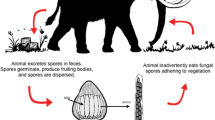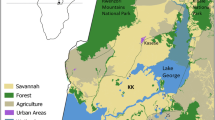Abstract
The use of non-pollen palynomorphs, and among them spores of coprophilous fungi, has become greatly important in palaeoecological studies. Particularly, the genus Sporormiella has been demonstrated to be the most valuable proxy for the presence of wild and domestic herbivores. This genus could also be used to determine livestock density and reconstruct pastoral pressure during the Holocene. Non-standard counting methods have been established to determine coprophilous fungal spore abundance in sediments. Moreover, these analyses are faced with the recurrent problem of setting the minimum counting sum as small as possible to save time. We researched the reliability of Sporormiella concentration estimates based on different counting sums, using low to high count samples. Box-plots indicate that the variability of inferred Sporormiella concentrations decreases progressively with increasing sums. Statistical comparisons show that the means of box-plots became stabilised after the counts have reached 300–350 exotic marker grains. Moreover, a count of 300–350 exotic marker grains is sufficient to produce a Sporormiella concentration estimate, whatever the amount. Finally, we propose that this counting limit is valid for other fungal spores as well.



Similar content being viewed by others
References
Ahmed SI, Cain RF (1972) Revision of Genera Sporormia and Sporormiella. Can J Bot 50:419–477
Baker AG, Bhagwat SA, Willis KJ (2013) Do dung fungal spores make a good proxy for past distribution of large herbivores? Quat Sci Rev 62:21–31
Birck C, Epaillard I, Leccia MF, Crassous C, Morand A, Miaud C, Bertrand C, Cavalli L, Jacquet S, Moullec P, Bonnet R, Sagot C, Franquet E, Nellier YM, Pergua ME, Cottin N, Pignol C, Malet E, Naffrechoux E, Giguet-Covex C, Jouffroy-Bapicot I, Etienne D, Millet L, Sabatier P, Wihelm B, Perren B, Arnaud F (2013) Sentinel lakes: a network for the study and management of mountain lakes in French Alps and in Corsica. Eco Mont 5:41–47
Conedera M, Tinner W, Neff C, Meurer M, Dickens AF, Krebs P (2009) Reconstructing past fire regimes: methods, applications, and relevance to fire management and conservation. Quat Sci Rev 28:555–576
Cugny C, Mazier F, Galop D (2010) Modern and fossil non-pollen palynomorphs from the Basque mountains (western Pyrenees, France): the use of coprophilous fungi to reconstruct pastoral activity. Veget Hist Archaeobot 19:391–408
Currás A, Zamora L, Reed JM, Garciá-Soto E, Ferrero S, Armangol X, Mezquita-Joanes F, Marqués MA, Riera S, Julià R (2012) Climate change and human impact in central Spain during Roman times: high-resolution multi-proxy analysis of a tufa lake record (Somolinos, 1,280 m asl). Catena 89:31–53
Davis MB (1969) Climate changes in southern Connecticut recorded by pollen deposition at Rogers Lake. Ecology 50:409–422
Doyen E, Vannière B, Berger JF, Arnaud F, Tachikawa K, Bard E (2013a) Land-use changes and environmental dynamics in the Upper Rhone valley since Neolithic times inferred from sediments in Lac Moras. Holocene 23:961–973
Doyen E, Vannière B, Bichet V, Gauthier E, Richard H, Petit C (2013b) Vegetation history and landscape management from 6500 to 1500 cal. b.p. at Lac d’Antre, Gallo-Roman sanctuary of Villards d’Héria, Jura, France. Veget Hist Archaeobot 22:83–97
Etienne D, Wilhelm B, Sabatier P, Reyss JL, Arnaud F (2013) Influence of sample location and livestock numbers on Sporormiella concentrations and accumulation rates in surface sediments of Lake Allos, French Alps. J Paleolimnol 49:117–127
Fægri K, Iversen J (1989) In: Fægri K, Kaland PE, Krzwywinski K (eds) Textbook of pollen analysis, 4th edn. Wiley, Chichester
Faith JT (2011) Late Pleistocene climate change, nutrient cycling, and the megafaunal extinctions in North America. Quat Sci Rev 30:1,675–1,680
Finsinger W, Tinner W (2005) Minimum count sums for charcoal-concentration estimates in pollen slides: accuracy and potential errors. Holocene 15:293–297
Gauthier E, Massa C, Bichet V, Vannière B, Petit C, Richard H (2010) Pollen and non pollen palynomorph evidence of medieval farming activities in Greenland. Veget Hist Archaeobot 19:427–438
Gill JL, Williams JW, Jackson ST, Donnelly JP, Schellinger GC (2012) Climatic and megaherbivory controls on late-glacial vegetation dynamics: a new, high resolution, multi-proxy record from Silver Lake, Ohio. Quat Sci Rev 34:66–80
Graf MT, Chmura GL (2006) Development of modern analogues for natural, mowed and grazed grasslands using pollen assemblages and coprophilous fungi. Rev Palaeobot Palynol 141:139–149
Heiri O, Lotter AF (2001) Effect of low count sums on quantitative environmental reconstructions: an example using subfossil chironomids. J Paleolimnol 26:343–350
Hicks S, Hyvärinen H (1999) Pollen influx values measured in different sedimentary environments and their palaeoecological implications. Grana 38:228–242
Maher LJJ (1972) Nomograms for counting 0.95 confidence limits of pollen data. Rev Palaeobot Palynol 13:85–93
Maher LJJ (1981) Statistics for microfossil concentration measurements employing samples spiked with marker grains. Rev Palaeobot Palynol 32:153–191
Maher LJJ, Heiri O, Lotter AF (2013) Assessment of uncertainties associated with paleolimnological laboratory methods and microfossils analysis. In: Birks HJB, Lotter AF, Juggins J, Smol JP (eds) Tracking environmental change using lake sediments. Springer, Berlin, pp 143–166
Mighall TM, Martínez-Cortizas A, Biester H, Turner SE (2006) Proxy climate and vegetation changes during the last five millennia in NW Iberia: pollen and non-pollen palynomorph data from two ombrotrophic peat bogs in the North Western Iberian Peninsula. Rev Palaeobot Palynol 141:203–223
Mosimann JE (1965) Statistical methods for the pollen analyst: multinomial and negative multinomial techniques. In: Kummel B, Raup D (eds) Handbook of paleontological techniques. Freeman, San Francisco, pp 636–673
Parker NE, Williams JW (2011) Influences of climate, cattle density, and lake morphology on Sporormiella abundances in modern lake sediments in the US Great Plains. Holocene 22:475–483
Payne RJ, Mitchell EAD (2009) How many is enough? Determining optimal count totals for ecological and palaeoecological studies of testate amoebae. J Paleolimnol 42:483–495
Quesada M, Bollman K, Stephenson AG (1995) Leaf damage decreases pollen production and hinders pollen performance in Cucurbita texana. Ecology 76:437–443
Raper D, Bush M (2009) A test of Sporormiella representation as a predictor of megaherbivore presence and abundance. Quat Res 71:490–496
R Core Team (2013) R: A language and environment for statistical computing. R Foundation for Statistical Computing, Vienna, Austria. http://www.R-project.org/
Stockmarr J (1971) Tablets with spores used in absolute pollen analysis. Pollen Spores 13:615–621
Thomson VP, Nicotra AB, Cunningham SA (2004) Herbivory differentially affects male and female reproductive traits of Cucumis sativus. Plant Biol 6:621–628
Van der Linden M, Kooistra L, Engels S (eds) (2012) Non-pollen palynomorphs as relevant indicators in palaeoecology and archaeobotany. (Rev Palaeobot Palynol 186) Elsevier, Amsterdam
Van Geel B, Aptroot A (2006) Fossil ascomycetes in Quaternary deposits. Nova Hedwig 82:313–329
Van Geel B, Buurman J, Brinkkemper O, Schelvis J, Aptroot A, van Reenen GBA, Hakbijl T (2003) Environmental reconstruction of a Roman Period settlement site in Uitgeest (The Netherlands), with special reference to coprophilous fungi. J Archaeol Sci 30:873–883
Walanus A, Nalepka D (2013) Information content of zero pollen counts in Holocene profiles. Holocene 23:732–738
Wilhelm B, Arnaud F, Sabatier P, Crouzet C, Brisset E, Chaumillon E, Disnar JP, Guiter F, Malet E, Reyss JL, Tachikawa K, Bard E, Delannoy JL (2012) 1400 years of extreme precipitation patterns over the Mediterranean French Alps and possible forcing mechanisms. Quat Res 78:1–12
Wood JR, Wilmshurst JM (2013) Accumulation rates or percentages? How to quantify Sporormiella and other coprophilous fungal spores to detect late Quaternary megafaunal extinction events. Quat Sci Rev 77:1–3
Wood JR, Wilmshurst JM, Worthy TH, Cooper A (2011) Sporormiella as a proxy for non-mammalian herbivores in island ecosystems. Quat Sci Rev 30:915–920
Acknowledgments
Logistical and financial support were provided by the Museum of Prehistoric Anthropology of Monaco (Jérôme Magail dir.), the French National Research Agency‘s Pygmalion project (ANR BLAN07-2_204489) and the National Park of Mercantour. The authors thank Julien Didier for chemical preparation and Elise Doyen for pollen data. The comments of Bas van Geel and an anonymous reviewer greatly helped to improve the manuscript.
Author information
Authors and Affiliations
Corresponding author
Additional information
Communicated by W. Tinner.
Rights and permissions
About this article
Cite this article
Etienne, D., Jouffroy-Bapicot, I. Optimal counting limit for fungal spore abundance estimation using Sporormiella as a case study. Veget Hist Archaeobot 23, 743–749 (2014). https://doi.org/10.1007/s00334-014-0439-1
Received:
Accepted:
Published:
Issue Date:
DOI: https://doi.org/10.1007/s00334-014-0439-1




